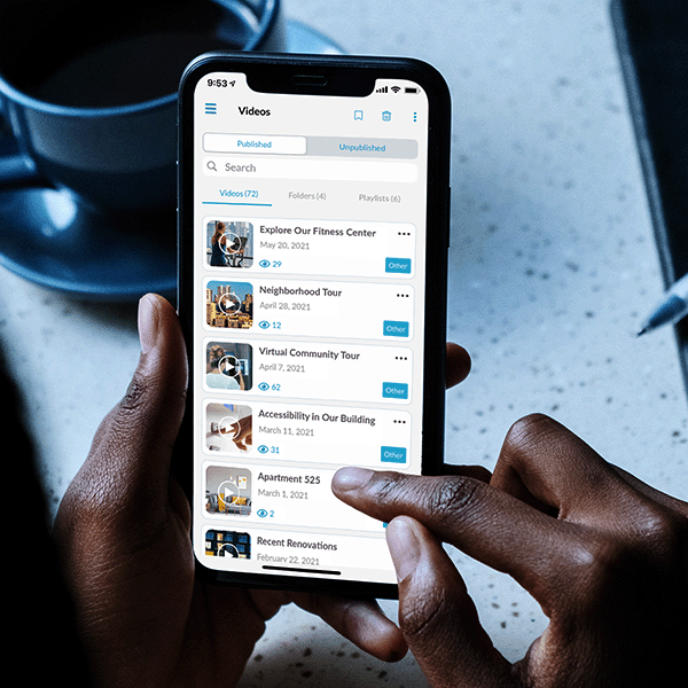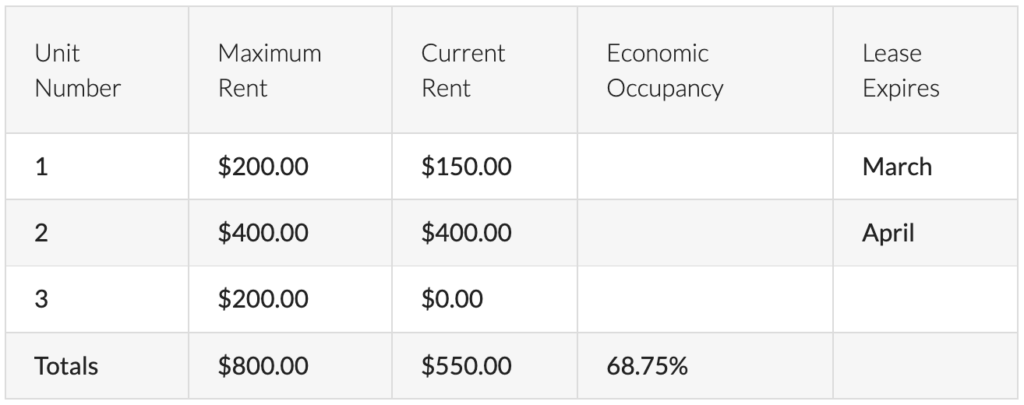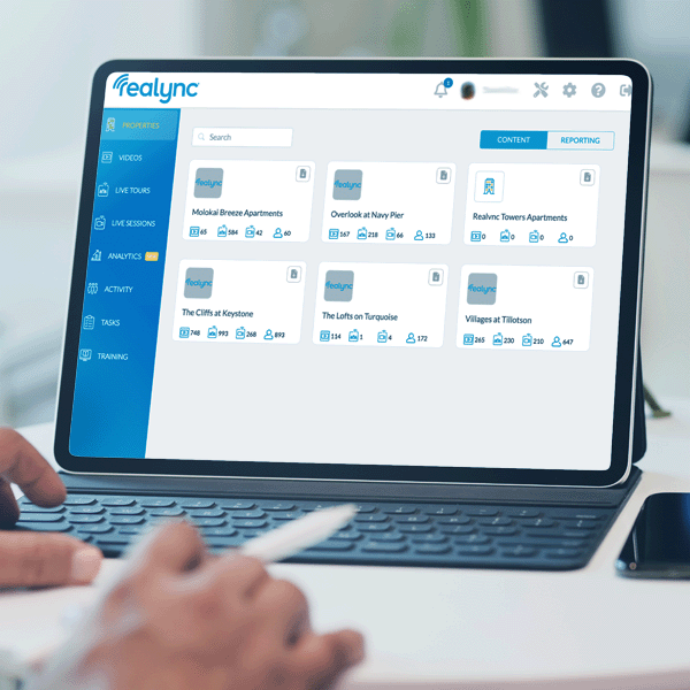
How Can an Apartment Occupancy Calculator Save You Time and Money?
It’s important to know the occupancy rate for an apartment building as an investor or multifamily professional for various reasons. First, this number helps you identify anticipated cash flow and if you should pivot your current leasing strategy.
Continue reading below to learn more about calculating your apartment occupancy rate. If you found this information helpful, subscribe to the Realync newsletter to learn more about improving the performance of your communities.

Apartment Occupancy Calculator
The apartment occupancy rate is the ratio of rented units or gross income as compared to the maximum potential. It can be calculated as physical occupancy or economic occupancy. It can be calculated at one point in time and can also be examined over time to detect trends. Knowing the occupancy rate is important for an apartment building investor for several reasons. The first is that it helps identify anticipated cash flow. It also can help you gauge how well the apartments are being managed. If the building you have invested in or anticipate investing in has a low occupancy rate relative to others around it, this may indicate that the building is in need of sprucing up, new marketing materials or better management. If the occupancy rate is higher than comparable apartment buildings nearby, this may indicate a well-managed and well-maintained property.
How Can an Apartment Occupancy Calculator Help Save You Time and Money?

Apartment Occupancy Rates
Regularly benchmarking occupancy rates of your apartment buildings against others in the area and country is important. What is a good occupancy rate for an apartment building? In 2022, a good occupancy rate is 93.8% – The national rental vacancy rate is 6.2%. a good occupancy rate against a national average is 96 percent or more. However, apartment occupancy rates do vary depending upon locality. However, as of December 2021, apartment occupancy has hit an all-time high – 97.5%. Residents aren’t having to relocate for jobs, resulting in one of the various reasons residents just aren’t moving.


Calculate Occupancy Rate
Three types of occupancy rates are important: physical, economic and room occupancy. All can be calculated either by using spreadsheet software, such as excel, or by using a calculator either online or on your phone.
Physical
Physical occupancy rate is the percentage of available rental space that is occupied with paying tenants. The occupancy rate formula for a particular month is number of units rented/ number available to be rented* 100. For example, you may have 50 units available for renting and 45 of them have paying tenants. To calculate physical occupancy rate, divide 45 by 50 for a total of .90. To express as a percentage multiply .90 by 100. The physical occupancy rate is 90 percent.
Some people confuse physical occupancy and leased occupancy. Here’s how to calculate the leased percentage: current number of units occupied + (number of units with signed leases yet to move in) / total number of units * 100%. This measurement can be misleading. For example, you may have units occupied with people moving out next month but also signed leases for people moving in next month. This would result is you showing an occupancy of more than 100 percent.
Economic
An economic occupancy rate is the proportion of the gross potential rent that is collected—the money that is actually paid to your business. The gross potential rent (GPR) is the amount of rent that would be collected if you rented out all the apartments at the amount of rent shown in the rental contract. The economic occupancy rate formula is (GPR minus deductions)/GPR * 100. To calculate the economic occupancy apartment building owners first calculate the GPR by multiplying the number of apartments by the amount of rent that you could charge for each; for example, 70 apartments at $200 each would yield a GPR of $14,000. Then deduct out the rent not received because units are vacant or occupied by someone who receives rent for free, such as the building supervisor, and the amount of discounts given. Let’s say that one apartment is vacant and one is occupied by a supervisor. Another apartment is discounted $100. That means you would deduct $500 from the $14,000 to get a total of $13,500. Divide $13,500 by $14,000 and multiply that by 100. Your economic occupancy rate is 96.4 percent.
Room
A room occupancy calculator is important to ensure that you comply with state laws regarding how many people can live in an apartment unit. The room occupancy formula is total square feet / number of tenants occupying the apartment. For example, New York law says that you must have at least 80 square feet per person. Suppose you have three people living in a two-room apartment. One room is 8×10 (80 square feet) and the other room is 12×14 (168 square feet). The total square footage is 248 (80 plus 168) Divide 248 by the number of tenants (3) to get 82.6. From this you determine that you have 82.6 square feet per person and are in compliance with the law.

Occupancy Forecast Formula
While knowing where you stand with occupancy at any given point in time is important, knowing where you are going is also important for developing a plan of how to increase apartment occupancy rates — both physical and economic — over time. To build an accurate forecast, you must first understand your occupancy patterns over time. This means keeping track of several months or years of data, perhaps on an Excel spreadsheet or in your property management software. In addition to historical physical and economic occupancy rate data, you would also keep track of when each lease will expire so that you can see in which months you potentially will have a vacancy and act early to prevent a vacancy. Keeping track of the amount of rent paid for each unit, as well as researching the amount of rent charged for comparable apartments in your area, will let you know which apartments might merit a rate increase. Since rent and physical occupancy in one apartment building are affected by the supply of similar housing in the same neighborhood, you would keep track of how much building is being done in your area, as well.

How to Calculate the Occupancy Rate in Excel
Excel is a good tool for calculating occupancy rates each month and over time. One example of how to calculate the occupancy rate in excel is to create a spreadsheet with pages for each month. You then enter the monthly data along with the occupancy formula in excel. An example of one page of the spreadsheet is below. In this example, which calculates economic occupancy, the maximum rent is listed for each unit in column B and a formula in the bottom row of column B totals the maximum rent. The current rent is listed in column c, with a formula in the bottom row to total that. Then the economic occupancy formula, in this case, c9/b9, is in the bottom row of column D. You change the formatting of the cell in excel to have this expressed as a percentage.


Vacancy Rate Calculator
The vacancy rate is the opposite of the physical occupancy rate. The rental vacancy rate formula is 100 minus the occupancy rate. For example, if your occupancy rate is 95 percent, the vacancy rate is 100 minus 95 or 5 percent. To benchmark your performance, compare your vacancy rate to the rental vacancy rate by city and state. For an even more accurate benchmark, compare with the rental vacancy rate by zip code. Related to the vacancy rate is the availability rate, which is the ratio of available space to total rentable space, calculated by dividing the total available square feet by the total rentable square feet.


Ready to Get Real?
Accelerate Leasing
Speed Up Lease Up
by providing construction updates and showcase your space without having to do hard hat tours.
PRE-LEASE OCCUPIED UNITS
by ‘showing’ them without having to physically tour the space by sending pre-recorded videos.
CONVERT A HIGHER PERCENTAGE OF YOUR LEADS INTO LEASES
when you receive notifications when prospects are viewing videos to cater your follow up.
SPEND LESS TIME TO CLOSE EACH LEASE
by removing roadblocks and barriers in the leasing process.
INCREASE SIGHT-UNSEEN LEASING
by making it a breeze for out-of-market leads to choose your community.
Improve Community Engagement
PROMOTE YOUR PROGRAMS BETTER
via pre-recorded videos by linking via social media or internal apps.
DECREASE MAINTENANCE REQUESTS
by creating maintenance videos.
REINFORCE COMMUNITY RULES
by receiving notifications when residents are viewing videos to know who has seen a message and who hasn’t.
REDUCE REPETITIVE QUESTIONS
because consumers retain 10% of a message when reading it via text, but 90% of a message when viewed in a video.
More Than Software
Virtual Training
is available for every property utilizing Realync.
Make your video efforts consistent
with one set, standardized process and platform.
TRACK ENGAGEMENT And Usage
across your entire portfolio.
Partner with the Realync Team
to create a personalized training program to be rolled out across all properties.
Are you Ready to Get Real?
Talk with us today to see how Realync’s platform can 4X your lead-to-lease conversion!
Request a Demo
